Japanese Yatai: The Enchanting World of Japan’s Mobile Street Food Stalls
As the sun sets over Japan’s bustling cities, something magical happens. Small, mobile food stalls – known as yatai (yah-tai) – emerge on street corners, alleyways, and alongside riverbanks. Steam rises from simmering pots, lanterns glow invitingly, and the tantalizing aroma of street food fills the air. These humble stalls offer not just delicious meals, but an authentic glimpse into Japan’s vibrant food culture and social traditions that have endured for centuries.
What Are Yatai? Japan’s Beloved Street Food Vendors
Yatai (屋台) are small, mobile food stalls that typically operate in the evening hours on Japanese streets. Traditionally wheeled out at dusk and packed away after the last customer leaves (often well after midnight), these compact culinary outposts represent one of Japan’s most accessible and authentic dining experiences.
A classic yatai consists of a simple wooden cart or small structure with a few seats (typically stools) arranged around a counter where the vendor prepares food in full view of customers. Many modern yatai have evolved to include more permanent features, though they maintain their intimate scale, typically accommodating between 6-10 customers at a time.
Key Features of Traditional Yatai:
- Mobility: Historically wheeled or carried to their locations each day
- Intimate setting: Small counter seating arrangements create a communal dining experience
- Open kitchen: Food preparation happens right before customers’ eyes
- Specialized menu: Most yatai focus on a specific type of food rather than offering extensive menus
- Evening operations: Primarily night-time businesses that create a vibrant after-dark food scene
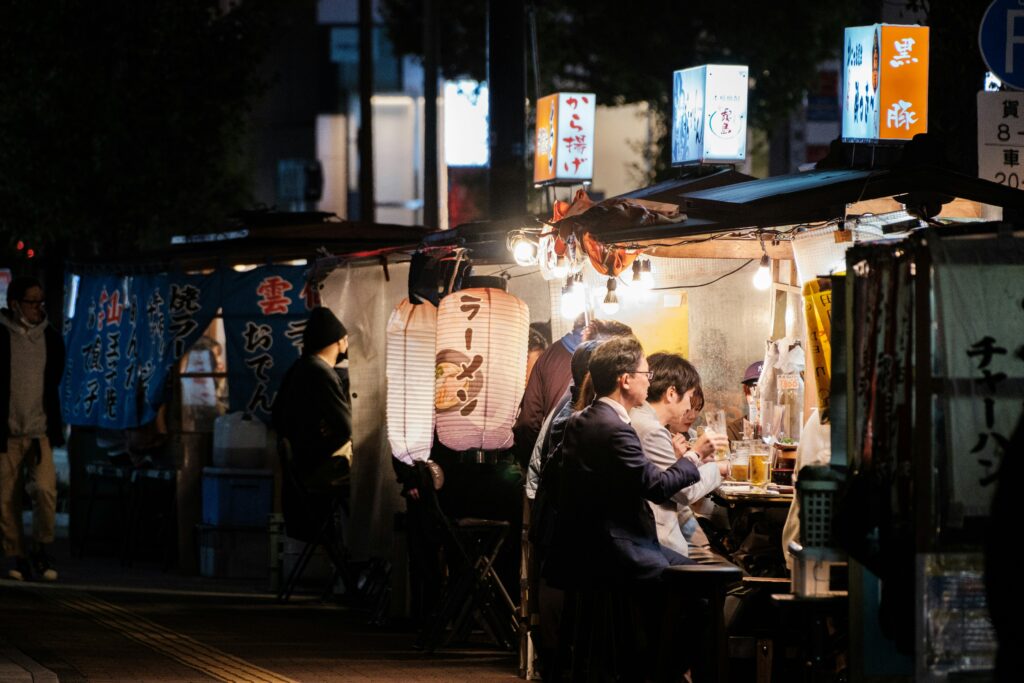
The Rich History of Yatai Culture
The tradition of mobile food vendors in Japan dates back to the Edo period (1603-1867), when merchants would wander the streets with portable food stands hanging from shoulder poles. During this time, elaborately decorated stalls called koshi-nabe served hot pot dishes to pedestrians, while others specialized in sushi, tempura, or grilled foods.
Yatai culture flourished particularly after World War II, when food shortages and economic hardship made these affordable food options essential for urban workers. The post-war era saw yatai become important community hubs where people from all walks of life could gather, share a meal, and find brief respite from the challenges of rebuilding the nation.
Did you know? During the Meiji era (1868-1912), there were estimated to be over 40,000 yatai operating in Tokyo alone! Today, regulatory changes have dramatically reduced these numbers, with Fukuoka city now being home to the most famous concentration of traditional yatai.
While yatai once faced significant decline due to modernization and stricter health regulations, recent years have seen a revival of interest in this nostalgic form of dining. Today’s yatai represent a balance between tradition and adaptation, with many young entrepreneurs bringing contemporary touches to this historic food culture.
Regional Yatai Specialties Across Japan
While yatai can be found throughout Japan, certain regions have developed distinctive yatai traditions and specialties:
Fukuoka: The Yatai Capital
Fukuoka city, particularly the Nakasu and Tenjin districts, is widely regarded as Japan’s yatai capital. With around 150 stalls operating regularly, Fukuoka’s yatai are famous for serving tonkotsu ramen – a rich, pork-bone broth noodle soup that has gained international fame. Other Fukuoka yatai specialize in gyoza (dumplings), oden (simmered ingredients in dashi broth), and various yakitori (grilled chicken skewers).
Osaka: Street Food Heaven
Osaka, known as “Japan’s kitchen,” has a vibrant yatai culture centered around its famous street foods. Here you’ll find stalls serving takoyaki (octopus-filled batter balls), okonomiyaki (savory pancakes), and kushi-katsu (deep-fried skewered meats and vegetables). Many Osaka yatai reflect the region’s reputation for bold flavors and hearty portions.
Tokyo: Urban Evolution
While traditional yatai are less common in Tokyo due to strict regulations, the capital has seen a modern reinvention of street food culture. Contemporary yatai-inspired vendors operate at festivals, special events, and designated areas, offering everything from regional specialties to innovative fusion foods that reflect Tokyo’s cosmopolitan character.
Popular Yatai Foods: What to Order
Yatai menus vary widely depending on location and the vendor’s specialty, but some of the most beloved yatai offerings include:
- Ramen: Particularly popular at Fukuoka yatai, where the local tonkotsu style features a rich, milky pork bone broth
- Oden: A winter favorite consisting of various ingredients like daikon radish, boiled eggs, fish cakes, and konjac simmered in a light dashi broth
- Yakitori: Skewered chicken pieces grilled over charcoal, ranging from familiar cuts like thigh and breast to more adventurous options like heart, liver, and skin
- Takoyaki: Ball-shaped snacks filled with octopus pieces, tempura scraps, and green onion, topped with special sauce, mayonnaise, and bonito flakes
- Okonomiyaki: Savory pancakes containing various ingredients like cabbage, meat, seafood, and topped with distinctive sauces and garnishes
- Imagawayaki: Sweet pancake-like treats filled with red bean paste or other fillings
“Yatai food has a special flavor that cannot be replicated in regular restaurants. Perhaps it’s the open air, the casual setting, or the chef’s personality – but there’s something magical about these simple meals served in the glow of paper lanterns.” – Japanese food writer
The Social Experience: More Than Just Food
What makes yatai truly special isn’t just the food – it’s the unique social atmosphere they create. The intimate counter seating arrangement naturally facilitates conversation, not only between friends but also between strangers who might never interact in other settings.
This social aspect reflects the Japanese concept of ittadarakasa – a temporary letting go of social hierarchy and formality. At a yatai, company executives might find themselves seated beside students or laborers, all enjoying the same simple, delicious food. The casual nature of yatai creates a democratic space that contrasts with Japan’s otherwise hierarchical society.
For foreign visitors, yatai provide an accessible entry point into Japanese food culture and opportunities for authentic interaction with locals. Many yatai vendors are chatty and welcoming, often going out of their way to make foreign guests feel comfortable despite potential language barriers.
Cultural note: In Japan, it’s considered polite to eat all your food at yatai, as it shows appreciation for the chef’s efforts. If you’re full, it’s better to order less initially than to leave food uneaten. Also, at busy yatai, it’s customary not to linger too long after finishing your meal, as others may be waiting for seats.
Experiencing Yatai as an American Traveler
For Americans visiting Japan, yatai offer an authentic cultural experience that combines incredible food with genuine social interaction. Here are some tips for making the most of your yatai adventure:
Tips for Enjoying Yatai:
- Look for activity: The busiest stalls are usually serving the best food – follow the locals!
- Be adventurous: Many yatai specialize in one dish they’ve perfected – trust the chef’s expertise
- Bring cash: Most smaller yatai don’t accept credit cards
- Learn basic phrases: Even simple Japanese like “Oishii!” (Delicious!) will be appreciated
- Don’t be intimidated: Yatai vendors are generally welcoming to foreigners and may be eager to share their culture
- Be weather-aware: Many yatai have limited shelter, so check the forecast before planning your visit
- Respect the space: These are small venues, so be mindful of other diners and the limited seating
Best Places for Americans to Experience Yatai
While traditional yatai can be found throughout Japan, these locations offer particularly accessible and rewarding experiences for foreign visitors:
- Fukuoka’s Nakasu area: The highest concentration of authentic yatai in Japan, with many vendors accustomed to international visitors
- Osaka’s Dotonbori district: While not all are traditional yatai, the street food scene here is vibrant and foreigner-friendly
- Seasonal festivals: Events like summer matsuri (festivals) often feature temporary yatai stalls serving festival foods
- Hoppy Street in Tokyo’s Asakusa: A street lined with yatai-style establishments serving food alongside hoppy (a beer-like beverage)
- Sapporo’s Ramen Alley: While technically small restaurants rather than true yatai, this collection of tiny ramen shops captures a similar intimate dining experience
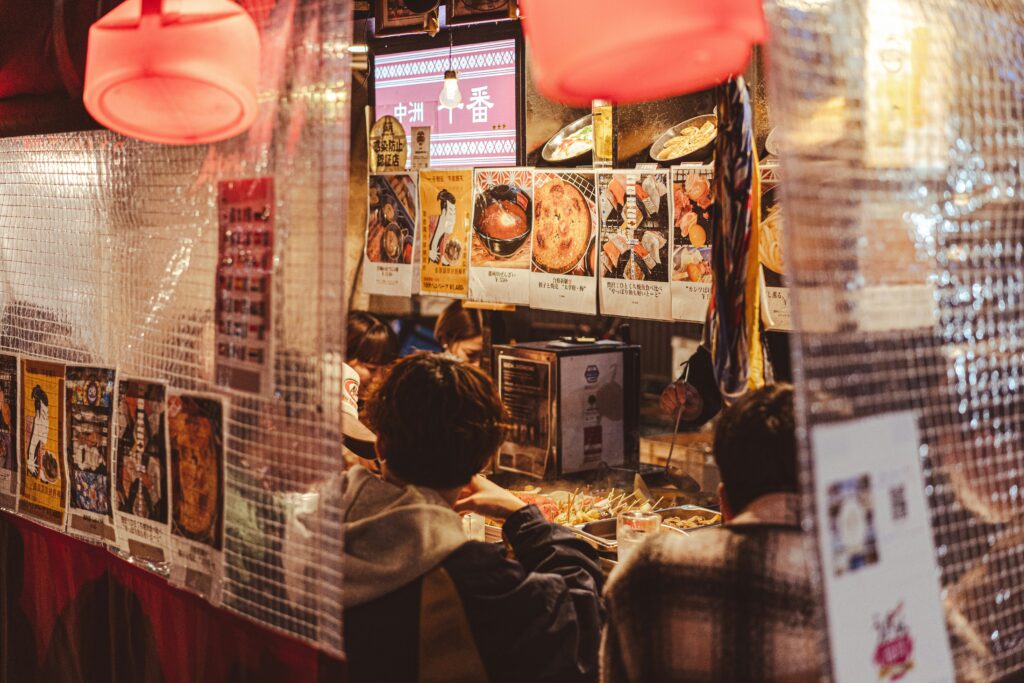
The Future of Yatai: Tradition Meets Innovation
Like many traditional practices in Japan, yatai culture faces both challenges and new opportunities. Strict health regulations, urban development, and changing lifestyles have reduced the number of traditional yatai operating in Japan. However, recent years have seen renewed interest in this cultural institution.
Young entrepreneurs are opening modern interpretations of yatai, sometimes incorporating international influences while respecting the intimate, personalized experience that makes these establishments special. Some cities are designating special areas where yatai can operate legally, recognizing their cultural and touristic value.
The COVID-19 pandemic initially hit yatai vendors hard, but their open-air nature and small scale have actually become advantages in the era of social distancing, allowing them to adapt more quickly than larger restaurants.
For travelers seeking authentic food experiences, yatai represent something increasingly rare in our globalized world – hyper-local, personality-driven food businesses that emerge from and serve their immediate communities. As interest in sustainable, small-scale food systems grows worldwide, Japan’s centuries-old yatai tradition offers both inspiration and practical wisdom.
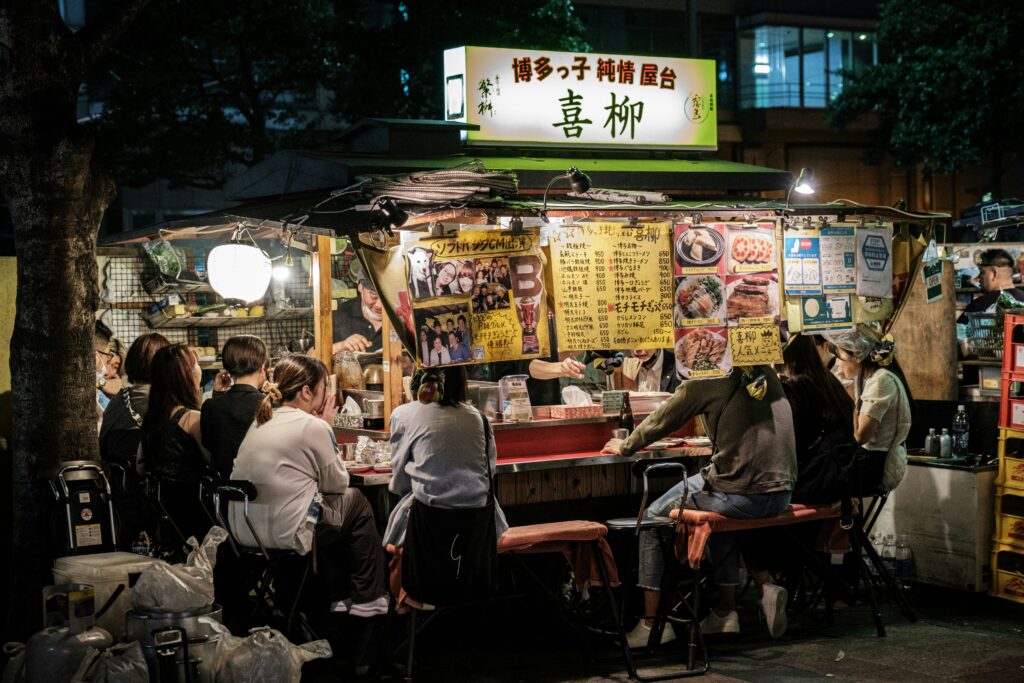
Conclusion: The Enduring Magic of Yatai
Japanese yatai embody something beyond mere food service – they represent a cultural approach that values intimacy, craftsmanship, and community. In a world increasingly dominated by chain restaurants and food delivery apps, these humble street stalls remind us of the special connection that can form between a chef, their carefully prepared food, and the customers who gather around their counter.
For visitors to Japan, seeking out authentic yatai experiences offers not just memorable meals, but windows into Japanese social life that might otherwise remain inaccessible. Each steaming bowl of ramen or sizzling skewer of yakitori comes with something no luxury restaurant can provide: a genuine slice of everyday Japanese culture, served with pride by passionate culinary artisans who keep this beautiful tradition alive night after night.
Whether you find yourself perched on a stool beside Fukuoka’s canals or discovering a festival yatai in a mountain village, these encounters with Japan’s street food culture are likely to become some of your most treasured travel memories – proving that sometimes, the most authentic experiences come from the simplest settings.
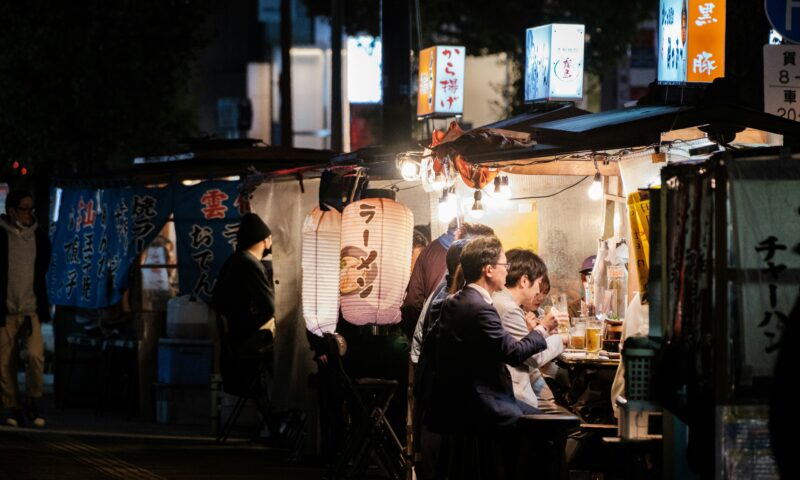

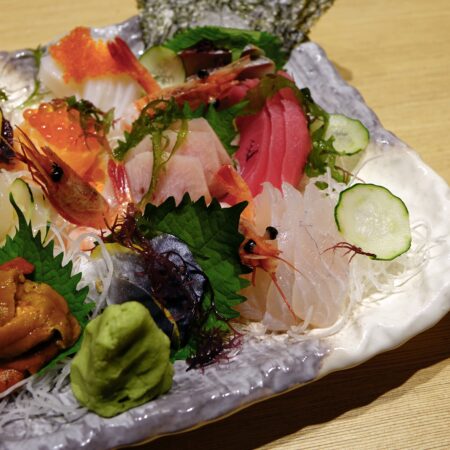


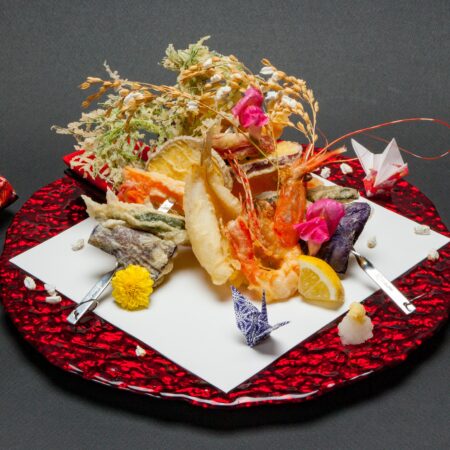

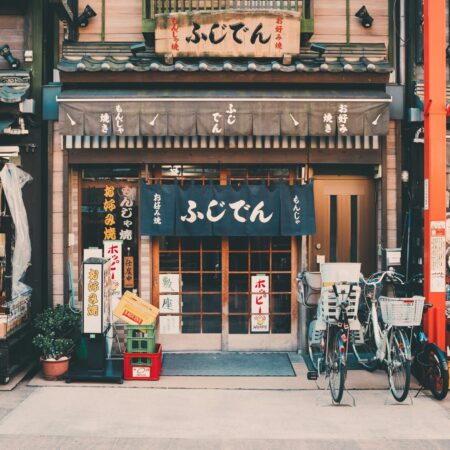
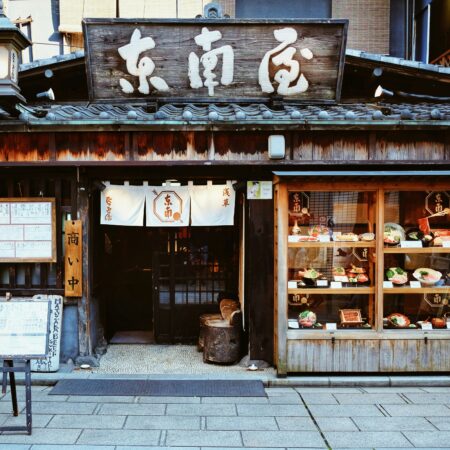
コメント